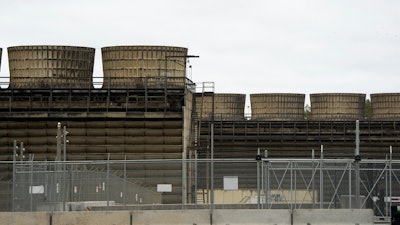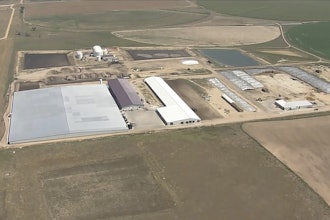
Minnesota regulators knew four months ago that radioactive waste had leaked from a nuclear power plant in Monticello — but they didn't announce anything about the leak until this week.
The delay in notifying the public about the November leak raised questions about public safety and transparency, but industry experts said Friday there was never a public health threat. They said Xcel Energy voluntarily notified state agencies and reported the leak of tritium to the Nuclear Regulatory Commission soon after it was confirmed and that the leak of 400,000 gallons (1.5 million liters) of radioactive water never reached a threshold that would have required public notification.
"This is something that we struggle with because there is such concern with anything that is nuclear," said Victoria Mitlyng, a spokesperson with the Nuclear Regulatory Commission. "The concern is very, very understandable. That is why I want to make extra clear the fact that the public in Minnesota, the people, the community near the plant, was not and is not in danger."
State officials said that while they knew of the leak in November, they waited to get more information before making a public announcement.
"We knew there was a presence of tritium in one monitoring well, however Xcel had not yet identified the source of the leak and its location," Minnesota Pollution Control Agency spokesperson Michael Rafferty said Thursday. "Now that we have all the information about where the leak occurred, how much was released into groundwater and that contaminated groundwater had moved beyond the original location, we are sharing this information."
Tritium is a radioactive isotope of hydrogen that occurs naturally in the environment and is a common by-product of nuclear plant operations. It emits a weak form of beta radiation that does not travel very far and cannot penetrate human skin, according to the Nuclear Regulatory Commission.
Edwin Lyman, director of nuclear power safety with the Union of Concerned Scientists, said a significant health risk would only occur if people consumed fairly high amounts of tritium. That risk is contained if the plume stays on the company's site, which Xcel Energy and Minnesota officials said is the case.
If regulatory officials are sure it didn't move off site, people shouldn't have to worry about their safety, he said, adding that companies usually take action when onsite monitoring wells detect elevated levels of contaminants like tritium.
Mitlyng said there's no official requirement for nuclear plants to report all tritium leaks to the Nuclear Regulatory Commission. Instead, Xcel Energy had previously agreed to report certain tritium leaks to the state. When Xcel Energy shares information with the state, it also shares it with the commission.
The commission posted a notification about the leak on its website Nov. 23, noting that the plant reported it to the state a day earlier. The report classified the leak as a nonemergency. The notice said the source of the tritium was being investigated at that time.
Beyond that, there was no widespread notification to the public before Thursday.
Rafferty said disclosure requirements fall to the facility, and state agencies would have notified residents immediately had there been an imminent threat to health and the environment.
Rafferty said the Minnesota Pollution Control Agency decided to share information about its role overseeing the cleanup now "because we have more details about the location and potential movement of the contamination, steps being taken to control the plume and plans for remediation including short-term storage of contaminated water."
Mitlyng said there is no pathway for the tritium to get into drinking water. The facility has groundwater monitoring wells in concentric circles, and plant employees can track the progress of contaminants by looking at which wells detect higher amounts. There are Nuclear Regulatory Commission inspectors on site too, watching over the response.
The company said the leak came from a pipe between two buildings.
Xcel said it has recovered about 25% of the spilled tritium so far, that recovery efforts will continue and that it will install a permanent solution this spring.
Xcel is considering building above-ground storage tanks for the contaminated water it recovers and is considering options for the treatment, reuse or final disposal of the collected tritium and water. State regulators will review the options the company selects, the state Pollution Control Agency said.
The regulatory commission said tritium spills happen from time to time at nuclear plants, but they've either been limited to plant properties or involved such low offsite levels that they didn't impact public health. Xcel Energy reported a small tritium leak at Monticello in 2009.
The Monticello plant is about 35 miles (55 kilometers) northwest of Minneapolis, upstream from the city on the Mississippi River.
Shelby Burma, who lives minutes from the site of the spill, said the news — coming weeks after a train derailment on the Ohio-Pennsylvania border left lingering concerns about contaminated air, soil and groundwater — makes her worry about an increasing amount of chemicals in the environment.
"I think it's pretty alarming that they did not notify the public right away," Burma said. "They said it won't cause any harm, but that's hard to believe when they waited how long to go public with it."
___
Associated Press writers Trisha Ahmed contributed to this report.






















